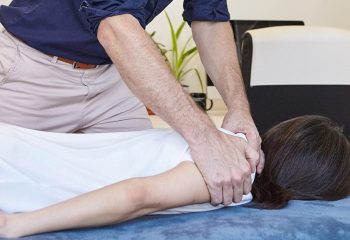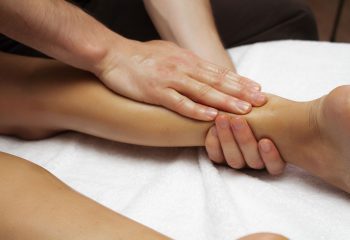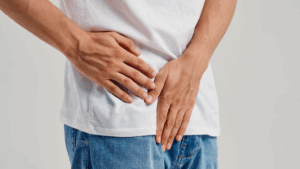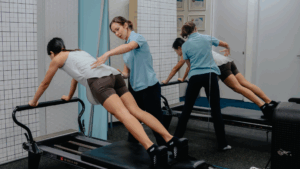How does your body change with pregnancy?
As pregnancy progresses, your body changes in many wonderful ways to help your child develop. Your body produces more of certain hormones to allow your muscles and ligaments to stretch and accommodate your child as it grows bigger every day. Your body stores more fluid to increase your blood volume so that you can provide nutrients to your growing baby. These changes are necessary, but they also put extra stress on your body and can cause discomfort.
Pregnancy-related changes can cause some of the pains and issues below. Read on to find out more about why these changes happen and also some simple stretches or exercises that may help to relieve some of these pains!
1. Pregnancy Related Low Back Pain
As baby grows heavier, the muscles of your abdominal wall stretch, your center of gravity is also brought upward and forwards. These changes increase the stress placed on the muscles in your lower back. If your back and abdominal muscles lack strength or flexibility, you may experience pain back pain, some women experience low back pain which runs down into their legs, this is known as sciatica.
Simple stretches you can try to address lower back pain during pregnancy:
1. Lower Back Release
Start by laying flat on the ground with a mat. Rest the feet on the medicine ball and gently roll the ball towards and away from you
2. Piriformis Stretch
Lie on your back with your legs straight. Lift your right leg and bend your knee. Raise your right hand up, and extend to the right. Maintain breathing through the stretch. Stay in this pose for 1 minute.
3. Child’s Pose with Side Stretch
Start with kneeling and sitting on your knees. Lean forward, keeping your buttocks on your heels, and rest your forehead on the floor. Use your hands to crawl and stretch the body and hip towards the left. Maintain the form for 10 seconds and repeat the same motion on the other side.
2. Pregnancy related neck and upper back pain
As the due date draws near, your milk ducts will start to become active in anticipation of baby’s arrival. You may have realized that your breasts have become fuller, and your usual bras now feel tight because of these changes. The muscles in your upper back and neck can become tight and painful with the increased load and change I posture caused by the increase in cup size.
Simple stretches you can try to reduce neck and back pain during pregnancy:
1. Upper Back Stretch
Ensure that your seating position has space for your head to lean against the crossed arms on the table. Take deep breaths in while raising the body and exhale to release the tension from the body.
2. Neck stretch
Place a finger on the chin and push such that the chin and head are pulled straight back and a good stretch is felt at the base of the head and the top of the neck. Hold for 5 seconds.
3. Side Neck Stretch
Slowly bend the head to one side, such as by bringing the left ear toward the left shoulder. Use your arm to aid the bending of the neck. Hold for 10 seconds and repeat for the other side.
3. Pregnancy related wrist/hand pain
The natural increase in blood volume during pregnancy ensures that baby can be supplied with nutrition. However, this means that excess fluid can enter tissues within the hands and feet causing swelling. When tissues in the wrist swell, nerves that run through a narrow tunnel in the wrist called the carpel tunnel can become compressed causing pain, numbness, or weakness of the hand.
Simple prenatal care to help with wrist & hand pains:
1. Wrist Stretch
Extend the arm and use the other arm to gently pull the top of the hand inward. Hold for a few seconds and repeat on the other side.
2. Hand Mobilisation
Start by clenching the hand into a fist. Gradually stretch and flex the fingers back and forth from the palm as much as possible. Repeat for your other hand.
4. Pregnancy related rib pain
As your baby grows, it takes up more space within your abdomen. In the third trimester, baby pushes up against your ribs pushing them upwards and closer together. The abdominal muscle and the diaphragm that help with breathing are stretched as well. These changes can make breathing more effortful, the muscles between the ribs have work harder as well. Sometimes, these changes can cause rib pain with breathing.
Simple antenatal self-care to relieve rib pains during pregnancy:
Lower Back and Rib Mobilisation
Lie on your back with knees bent and claves resting on an exercise ball. Maintain stability on the upper body by spreading the hands out. Using the hips, slowly roll the exercise ball with your calves from left and right.
5. Pregnancy-related round ligament pain

As baby develops, the uterus grows out of the pelvis into the abdomen. A pair of ligaments known as the round ligaments undergo a lot of stretch as a result. Some women experience sharp pain with prolonged walking, sudden change in position or with coughing.
Simple stretches to relieve pelvic pain during pregnancy:
Gentle stretching and exercising are helpful for pain in the pelvic area for pregnant women, here are some you can try to relieve pelvic pain during pregnancy.
Child’s Pose with Side Stretch
Start with kneeling and sitting on your knees. Lean forward, keeping your buttocks on your heels, and rest your forehead on the floor. Use your hands to crawl and stretch the body and hip towards the left. Maintain the form for 10 seconds and repeat the same motion on the other side.
6. Pregnancy-related hip and groin pain (pubis symphysis pain / sacroiliac joint pain)
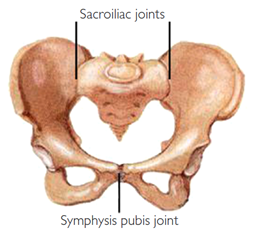
Hormonal changes in that allow your body to accommodate the growing baby reduces the tolerance that joints have for carrying weight. This means that your joint become more sensitive to heavy loads and can become painful more easily if the muscles that support the joints lack strength and flexibility. The sacroiliac and symphysis pubis joints carry increased load due to the growing baby and can become painful in pregnancy.
Here are some simple exercises that help strengthen the muscles around your hips:
1. Supported Pelvic Tilt
Start by sitting on an exercise ball. Tighten your abdominal muscles and bend your pelvis up slightly. Relax and allow your pelvis to shift back. Continue this back and forth motion to strengthen the abdominal muscles and pelvic floor.
2. Bridge Pose
Lie on your back and bend your knees. Point your knees up to the sky with the soles of your feet on the ground. With your palms face down, extend your arms long to each side of your body. Spread your feet to hip-width distance, so your fingertips graze the back of your heels. Press down through your feet and hands, and lift your hips off the ground without squeezing your glutes.
3. Hip Flexor Stretch
Kneel on one leg and bend your other leg out in front of you, with that foot flat on the floor. If you feel discomfort in the front of your knee, place a towel under your knee. Keeping your back straight, slowly push your hips forward until you feel a stretch in the upper thigh of your back leg and hip. Hold for 15 to 30 seconds. Repeat on the other leg.
7. Frequent urination in pregnancy
As the baby grows and occupies more space in your pelvis and abdomen, baby will be pressing on your bladder reducing the amount of urine it can store comfortably before giving you a signal that you need to go to the toilet. Having good drinking habits and good control of your pelvic floor muscles helps to keep your bladder healthy for good bladder control.
8. Urine and anal (gas or stools) leakage in pregnancy (incontinence during pregnancy)

The pelvic floor muscle slings across the bottom of the pelvis, this muscle is stretched as pregnancy progresses as it supports the weight of the growing baby. The pelvic floor muscle plays a key role in maintaining bladder and anal control, so a weakened pelvic floor can cause urine or gas leakage when you cough or sneeze. Urine leakage is
very common in pregnancy, about 2 in 3 women experience it in their 3rd trimester. Although it is common, urine leakage is not normal, learning how to exercise your pelvic floor muscle correctly is effective in addressing urine leakage.
During our prenatal sessions, learn how to turn on your pelvic floor muscle correctly (Kegel exercise) to strengthen the pelvic floor with the help of an Ultrasound. This allows you and the specialist to examine the muscles at work while you do the Kegel exercise and make sure they are done correctly.
9. Constipation in pregnancy
Pregnancy hormones can result in sluggish movement of the intestines, some women experience fewer bowel actions in pregnancy because of this. Compression of the intestines by the growing baby can slow intestinal movement further causing difficulty with passing motion and even constipation.
Drinking sufficient water, having a balanced diet and adequate exercise helps to maintain good bowel health in pregnancy and prevents the likelihood of constipation during pregnancy.
We hope that these stretches, exercises and tips recommended by our Women’s Health Specialist help our soon-to-be mummies out! We were only able to cover the most common pains and aches of pregnancy, if you have other concerns or pains,
do visit our clinic for a diagnoses and a personalised recovery plan, so that you and baby can have the smoothest pregnancy journey possible!
 As baby develops, the uterus grows out of the pelvis into the abdomen. A pair of ligaments known as the round ligaments undergo a lot of stretch as a result. Some women experience sharp pain with prolonged walking, sudden change in position or with coughing.
As baby develops, the uterus grows out of the pelvis into the abdomen. A pair of ligaments known as the round ligaments undergo a lot of stretch as a result. Some women experience sharp pain with prolonged walking, sudden change in position or with coughing.
 Hormonal changes in that allow your body to accommodate the growing baby reduces the tolerance that joints have for carrying weight. This means that your joint become more sensitive to heavy loads and can become painful more easily if the muscles that support the joints lack strength and flexibility. The sacroiliac and symphysis pubis joints carry increased load due to the growing baby and can become painful in pregnancy.
Hormonal changes in that allow your body to accommodate the growing baby reduces the tolerance that joints have for carrying weight. This means that your joint become more sensitive to heavy loads and can become painful more easily if the muscles that support the joints lack strength and flexibility. The sacroiliac and symphysis pubis joints carry increased load due to the growing baby and can become painful in pregnancy.
 The pelvic floor muscle slings across the bottom of the pelvis, this muscle is stretched as pregnancy progresses as it supports the weight of the growing baby. The pelvic floor muscle plays a key role in maintaining bladder and anal control, so a weakened pelvic floor can cause urine or gas leakage when you cough or sneeze. Urine leakage is
very common in pregnancy, about 2 in 3 women experience it in their 3rd trimester. Although it is common, urine leakage is not normal, learning how to exercise your pelvic floor muscle correctly is effective in addressing urine leakage.
During our prenatal sessions, learn how to turn on your pelvic floor muscle correctly (Kegel exercise) to strengthen the pelvic floor with the help of an Ultrasound. This allows you and the specialist to examine the muscles at work while you do the Kegel exercise and make sure they are done correctly.
The pelvic floor muscle slings across the bottom of the pelvis, this muscle is stretched as pregnancy progresses as it supports the weight of the growing baby. The pelvic floor muscle plays a key role in maintaining bladder and anal control, so a weakened pelvic floor can cause urine or gas leakage when you cough or sneeze. Urine leakage is
very common in pregnancy, about 2 in 3 women experience it in their 3rd trimester. Although it is common, urine leakage is not normal, learning how to exercise your pelvic floor muscle correctly is effective in addressing urine leakage.
During our prenatal sessions, learn how to turn on your pelvic floor muscle correctly (Kegel exercise) to strengthen the pelvic floor with the help of an Ultrasound. This allows you and the specialist to examine the muscles at work while you do the Kegel exercise and make sure they are done correctly.


